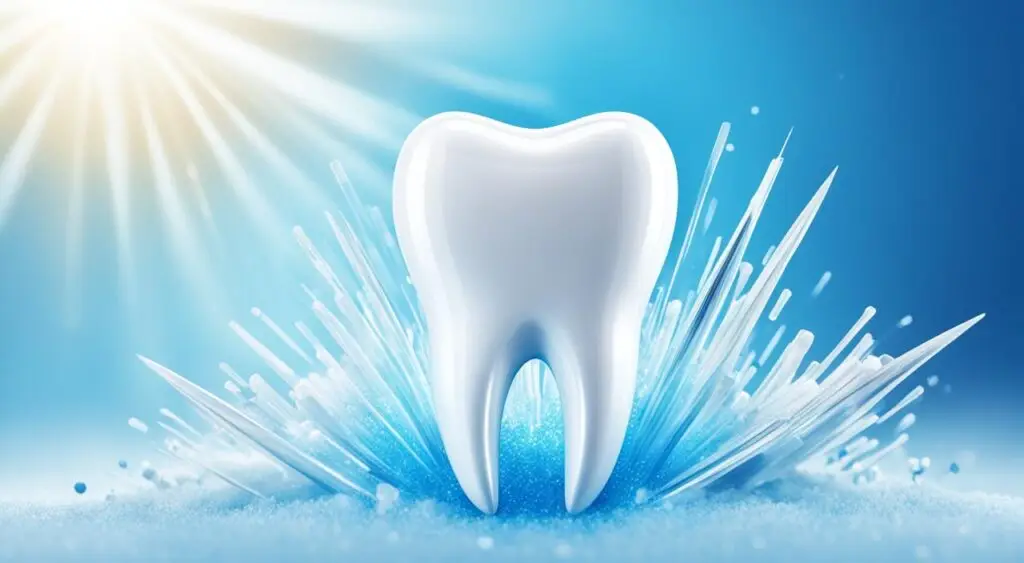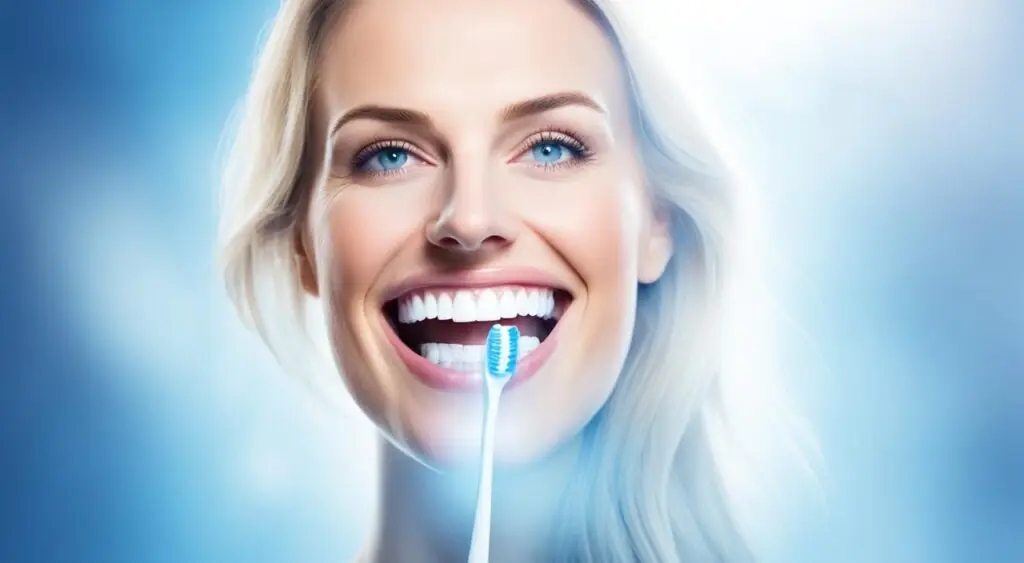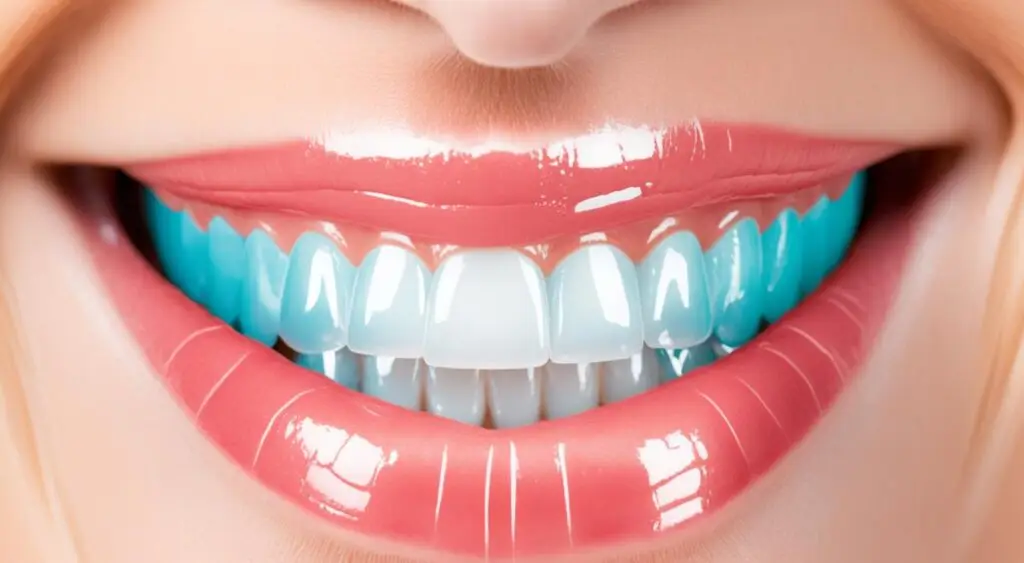When looking for the Best Toothpaste for Whitening, do you think about how it protects your teeth? There’s more than just a bright smile to consider. Fluoride plays a big role in fighting cavities and has been for years. It’s important in our daily dental care. It not only works in our water but also strengthens our teeth from the toothpaste itself.
Today’s toothpaste offers more than just fluoride. Our detailed review explores different ingredients that make a toothpaste great. These include tartar control, sensitivity relief, and whitening power. We used global studies and the American Dental Association’s (ADA) strict guidelines for our guide. Are you ready to find a toothpaste that both whitens and protects your teeth? Join us as we explore the best options for a healthy, bright smile.
Understanding Whitening Toothpastes and Their Ingredients
Looking for the best whitening toothpaste means understanding what’s in it. With so many choices, it’s important to know how they work. This knowledge lets you choose wisely, fitting your oral care needs.
Key Factors to Consider
Abrasive agents are key to whitening toothpastes, making up 8-20% of the formula. They remove surface stains. Knowing their Relative Dentin Abrasivity (RDA) is crucial. An RDA under 250 means the toothpaste is safe for daily use, as per dental standards.
Fluoride is also crucial, but its amount varies by country. In the U.S., it can be up to 1,100 parts per million. High fluoride levels, like 5,000 ppm, have shown to prevent decay in older adults. It’s important to check fluoride content.
Methodology of Product Testing
Our testing of whitening toothpastes is thorough and based on facts. We look at ingredients and their amounts, checking clinical results. This includes seeing how well they reduce plaque. A 2013 study found Triclosan cuts plaque by 22%.
We also compare how different toothpaste types lower plaque over time. This means looking at both chemical and natural toothpastes.
| Ingredient | Common Functionality | Clinical Findings |
|---|---|---|
| Abrasives | Stain removal | Safe up to 250 RDA |
| Fluoride | Prevent caries | 1,000-1,450 ppm in various regions |
| Triclosan | Plaque reduction | 22% reduction in plaque |
| Herbal Extracts | Natural plaque control | As effective as non-herbal pastes in short term |
Feedback from users on flavors, from mint to cinnamon, matters to us. We also check how toothpaste affects enamel. Keeping enamel healthy is key for whiter teeth.
Importance of ADA Approval
The ADA Seal of Acceptance is important. It shows a toothpaste is safe and works as claimed. Products with this seal have passed strict tests. This builds trust in their whitening claims.
In the end, understanding whitening toothpastes, their ingredients, and ADA approval helps. It ensures your oral care leads to a brighter smile while keeping your mouth healthy.
Determining the Best Toothpaste for Whitening
Looking for the best toothpaste for whitening can feel daunting. There are many products out there, all promising a bright smile. We’ll take a closer look at what makes a good whitening toothpaste. This includes their active ingredients and how they help whiten teeth.
It’s important for toothpaste to have enough fluoride. Research shows it strengthens teeth, even if your water has fluoride too. The ideal whitening toothpaste has over 1,000 ppm of fluoride. This fights cavities and helps fix the enamel. It should also have gentle polishers. These remove stains without harsh chemicals, making your teeth naturally white.
Now, let’s look at some top whitening toothpaste brands:
Burt’s Bees Deep Clean Whitening With Fluoride
This option uses fluoride to improve tooth health and natural ingredients to remove stains safely.
Crest Gum & Sensitivity Gentle Whitening
This toothpaste targets sensitivity and whitening. It whitens softly while providing fluoride, for those with sensitive teeth.
Colgate Baking Soda and Peroxide Whitening
Colgate combines baking soda and peroxide for a deep clean and slow whitening. This makes it a top choice for whitening.
Crest 3D White Professional Enamel Protect
This promises care like a pro’s. It doesn’t just whiten but also strengthens enamel with its ingredients and fluoride.
Toothpastes that fight plaque well can make teeth healthier and whiter. Toothpastes for sensitive teeth also work well, whitening gently. For best results, brush with your whitening toothpaste at night. Don’t rinse right away to keep fluoride and other agents on your teeth longer.
However, be careful in choosing a product. Some toothpastes from places with looser rules may have harmful substances, like diethylene glycol. Make sure your toothpaste is checked by reputable groups like the American Dental Association.

To sum it up, finding your best whitening toothpaste means looking for one with enough fluoride, gentle cleaning agents, and safety endorsements. Follow these tips to find a toothpaste that will give you the white smile you’re after.
Best Toothpaste for Whitening
A shining smile makes a big first impression. It’s the first thing half the people you meet notice. When looking for the best toothpaste for whitening, you’ll see many claims. We’ve researched to find the top whitening toothpastes that are both effective and safe.
The Crest 3D White Brilliance 2 Step Toothpaste stands out. It uses a two-part system for high-level whitening at home. It can make your smile almost as white as a professional treatment, at 99% of the whiteness.
The Crest 3D White Brilliance not only removes stains but also prevents new ones. It uses a special blend of ingredients that are safe on enamel. For those worried about sensitive teeth, Crest Whitening Emulsions provide a gentler option.
But, keeping your teeth white isn’t just about toothpaste. It’s also about your full dental care routine. Using a great toothbrush like the Oral-B iO Series 9 can help remove surface stains. A whitening mouthwash, like Crest 3D White Diamond Strong, can also remove stains and protect enamel.
| Criteria | Crest 3D White Brilliance 2 Step Toothpaste | Other Whitening Toothpastes |
|---|---|---|
| Whitening Efficacy | Up to 99% as white as professional polish | Varies, often less effective |
| Stain Prevention | Pyrophosphates for chemical action | May lack advanced chemical preventatives |
| Sensitivity | Enamel-safe with minimal sensitivity | Often causes sensitivity issues |
| Safety | Enamel-safe with added oral health benefits | Can be harsher on enamel |
Choosing the best toothpaste for whitening depends on your needs. Think about your gum and teeth’s health. While Crest 3D White Brilliance 2 Step Toothpaste is excellent, it’s good to consult with professionals. The right products and good oral hygiene will lead to a bright smile.

Crest 3D White Brilliance Vibrant Peppermint Teeth Whitening Toothpaste, 4.6 oz Pack of 3, Anticavity Fluoride Toothpaste, 100% More Surface Stain Removal, 24 Hour Active Stain Prevention
- Removes 100% More Surface Stains in 3 Days vs. Regular Toothpaste
Expert Tips for Maximizing Whitening Results
Getting a bright smile is more than just daily brushing. It’s about combining good products with the right habits. We will share expert tips on how to brighten your smile. These include good dental routines, extra treatments, and lifestyle changes.
Recommended Brushing Techniques
Brushing twice a day is essential, especially after eating. Use a soft brush and circular motions to avoid hurting your gums. This makes your whitening toothpaste work better. Dentists say to brush for two minutes, covering all tooth surfaces.
Use a whitening toothpaste with silica or hydrogen peroxide. These ingredients help remove stains and bleach your teeth. If you use whitening products regularly, you might see results in 2 to 6 weeks. These results can last up to 4 months.
Supplementing with Whitening Treatments
For tougher stains, you can add whitening strips, gels, or mouthwashes to your routine. Whitening strips are easy to use and can keep your teeth white for up to 6 months. Gel trays might show a brighter smile in a week and last over a year.
If you want professional help, a dentist can do bleaching that stays for up to 3 years. While there may be some sensitivity, it usually doesn’t last long.
Diet and Lifestyle Considerations for Maintaining a White Smile
Your daily choices affect how long your teeth stay white. Certain drinks like coffee, tea, and cola can stain your teeth. Drinking water after these or cutting back can help. Stopping smoking also improves your teeth’s color and health.
Eating crunchy fruits and veggies, and chewing sugar-free gum helps clean your teeth naturally. Though pricey, professional treatments can give better, safer results. Having a bright smile is important socially, which is why many seek whiter teeth. Using these tips with the right products and care, you can achieve a brighter smile.

Natural and Sensitive Options in Whitening Toothpastes
Keeping a bright smile doesn’t mean you have to sacrifice health or comfort. natural toothpaste solutions and sensitive options for teeth have changed how we look at dental care. There are more than 10 flavors available, from classic mint to fun bubblegum.
Recently, you might have seen many whitening toothpaste brands in the dental care aisle. Choosing a product that both brightens your smile and is gentle on your teeth is crucial. Many toothpastes not only fight stains but also contain fluoride to battle plaque, vital even for areas with fluoride in their water.
If you have sensitive teeth, finding comfort is key. Special toothpastes for sensitivity often have ingredients like potassium nitrate or strontium chloride. While they might take a month to work, these formulas are key for maintaining oral health and balance whiteness with gentleness.
Whitening toothpastes usually don’t have harsh bleaches. They rather use abrasive particles or bonding chemicals for cleaning and polishing. Studies show these products aren’t more harmful to enamel than non-whitening ones.
Choosing the right toothpaste depends on personal needs, like preferring all-natural ingredients or needing a sensitive option. It’s worth noting that ADA approval is a sign of trustworthiness, though some approved products have had issues, like harmful substances found in 2007.
- Looking for a natural whitening solution? Pick brands that skip artificial flavors and chemicals.
- For those with sensitive teeth, search for toothpastes that offer relief.
- Though some products claim quick results, true whitening requires consistent care over time.
Eighty percent of people aged 18 to 49 want whiter teeth, and the market is full of options. Brands like Crest Pro-Health, Sensodyne Extra Whitening, and Colgate Total Whitening compete with innovative products. Some use blue covarine, proving as effective as traditional methods.
The desire for a clean, white smile is strong. With many whitening toothpaste types and people spending $1.4 billion on whitening products, making an informed choice is critical. Whether you want a specific flavor, a natural option, or something for sensitive teeth, you have the power to improve your dental care and achieve your beauty goals.
FAQ
What factors should I consider when choosing a toothpaste for whitening?
When picking a whitening toothpaste, focus on the ingredients, its whitening power, and safety. Find ones with hydrogen peroxide or baking soda for good stain removal. Also, ensure it’s gentle enough for daily use, taking into account your teeth and gums’ sensitivity.
How do you test toothpastes for whitening?
We test whitening toothpastes by comparing before and after results. This shows how well they remove stains and brighten teeth. We also weigh user feedback and reviews to understand how satisfied people are with the product.
Why is ADA approval important for toothpaste products?
ADA approval is crucial as it vouches for the toothpaste’s safety and effect. The American Dental Association (ADA) checks toothpastes to ensure they are safe, have the right amount of active ingredients, and deliver promised benefits. Picking an ADA-approved toothpaste assures reliability.
What are some recommended toothpaste brands for whitening?
For whitening, some trusted brands include Burt’s Bees Deep Clean Whitening With Fluoride, Crest Gum & Sensitivity Gentle Whitening, Colgate Baking Soda and Peroxide Whitening, and Crest 3D White Professional Enamel Protect. These have earned positive feedback from users for their whitening capabilities.
Can you recommend the best toothpaste for whitening?
Our top choice for whitening toothpaste is Crest 3D White Professional Enamel Protect. It not only whitens effectively but also protects tooth enamel. Users have praised it for its performance, leaving teeth feeling clean and bright.
What are some expert tips for maximizing the results of using whitening toothpaste?
To get the best from your whitening toothpaste, brush correctly. Use gentle circular motions for at least two minutes, twice daily. Adding whitening treatments, like strips or gels, can boost effects. Also, avoiding foods and drinks that stain teeth will keep your smile brighter.
Are there natural or sensitive options in whitening toothpastes?
Yes, there are options for both natural and sensitive teeth. Natural toothpastes use plant-based ingredients without artificial additives. They’re great for those preferring organic oral care. For sensitive teeth, choose toothpastes made to whiten without causing discomfort.
What are some frequently asked questions about toothpaste for whitening?
Common questions about whitening toothpaste include: – Is it safe to use every day? – How long until I see results? – Can it remove deep stains? – Will it make my teeth sensitive? – Are all whitening toothpastes equally effective?








